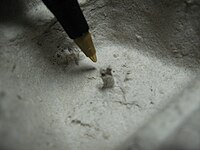This article needs additional citations for verification .(March 2022) |

Molded pulp or molded fiber (also spelled as moulded pulp or moulded fibre) is a packaging material, that is typically made from recycled paperboard and/or newsprint. It is used for protective packaging or for food service trays and beverage carriers. Other typical uses are end caps, trays, plates, bowls and clamshell containers. [1]
Contents
- Types of molded pulp
- Thick-wall
- Transfer molded
- Thermoformed fiber
- Processed
- See also
- References
- Books
For many applications, molded pulp is less expensive than expanded polystyrene (EPS), vacuumed formed polyethylene terephthalate (PET) and polyvinyl chloride (PVC), corrugation, and foams.
Molded pulp is often considered a sustainable packaging material, [2] as defined by the Sustainable Packaging Coalition, since it is produced from recycled materials, and can be recycled again after its useful life-cycle.
Molded pulp products can be made waterproof with a spray or dip coating of wax.



